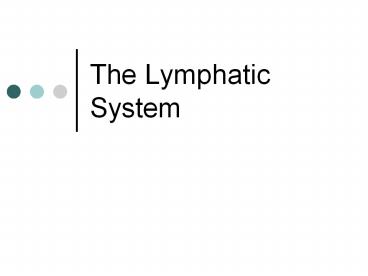The Lymphatic System PowerPoint PPT Presentation
1 / 13
Title: The Lymphatic System
1
The Lymphatic System
2
Non-Specific Defenses
- Physical Barriers
- Epithelium, hair, secretions, acid, enzymes
- Phagocytes
- 1st line of cellular defense removes debris and
pathogens - Microphages leave blood stream and enter
peripheral tissues (neutrophils and eosinophils) - Macrophages sensitive to chems in surrounding
fluids can be free or fixed - Interferons
- Slow spread of viral infections
- Stimulate macrophages and NK cells
- Inflammation
- Initiated by mast cells releasing histamines and
heparin - Local swelling, heat, redness, and pain
- Slows spread of pathogens
- Necrosis tissue destruction via lysosomes
- Pus accumulation of dead cells and debris
(abscess accumulation of pus) - Fever (gt98oF)
- Pyrogens proteins reset body's thermostat
- Incr. rate of metabolism
- Over 104oF damages CNS, nausea, hallucination,
and convulsions
3
Organization
- Lymph Vessels
- Begin at peripheral tissue? venous system
- Small valves prevent backflow
- Lymph Fluid
- Blood plasma but w/less proteins
- Lymphocytes
- Cells defend body
- 80 last 4 yearssome last 20 years or more!
- Lymph Tissue
- Loose connective tissue
- Tonsils, Appendix, Peyers Patches
- Size can increase or decrease depending on number
of lymphocytes - Lymph Organs
- Lymph nodes
- Spleen
- Thymus
4
Lymph Vessels
- Lead towards trunk of body and empty into 2 ducts
- Thoracic duct lower abdomen, pelvis, lower
limbs, left head, neck, and chest - Right lymphatic duct right side of body, above
diaphragm - Lymphodema (edema) blockage of lymph drain
5
Functions
- Protect body from pathogens
- Production, maintenance, and distribution of
lymphocytes - Return fluid from peripheral tissues to blood
- Distribute hormones, nutrients, and waste to
general circulation
6
Lymphoid Organs
- Lymph Nodes
- Filter and purify lymph before enters venous
system - Detects and removes antigens
- Stimulates T cells and B cells initiating immune
response - Lymphomas cancer arising from lymphocytes
- Thymus
- Decrease in size after puberty
- T cell production and maturation
- Spleen
- 5 long on left side, deep red
- Filters blood, removes abnormal blood cells and
initiates B cell and T cell responses to antigens - Macrophages identify and engulf damaged or
infected cells
7
Lymphocytes
- 25 of circulating wbc
- T cells thymus dependent (80 circulating
lymphocytes) - Cytotoxic T cells attack foreign cells or body
cells infected w/ virus - Helper T cells stimulate T cells and B cells
- Suppressor T cells inhibit T cells and B cells
- B cells -bone marrow derived (10-15 circ.
Lymphocytes) - Plasma cells secrete antibodies
(immunoglobulins) - Antibodies bind to antigens
- NK cells natural killer cells (5-10 circulating
lymphocytes) - Attack foreign cells, viral infected cells, and
cancer cells
8
Specific Defenses
- Immunity respond to the presence of specific
antigens - Antigens non-self substance that excites the
immune system and stimulates a response - Genes determine specificity
- T cells cell mediated immunity
- Defend against abnormal cells
- Pathogens inside of cells
- B cells antibody-mediated immunity
- Defend against antigens and pathogens in body
fluids - Antibodies (immunoglobulins) bind to specific
antigen, Y shape with 2 antigen binding sites
9
Immune Response (antibody mediated)
- B cell binds w/antigenbecomes activated and
produces clones - B cell clones
- Plasma cells secrete antibodies (2,000 per
sec!) reaches peak 10 days - Memory B cells continue to circulate, and can
speed process to 2-3 days if recognizes an old
enemy
10
Immune Response (cell mediated)
- T cells cannot bind to free antigen
- Macrophages and B cells must present antigen to T
cells - Once T cell binds to presented antigen
- Killer (cytotoxic) T cells
- Binds to target cell and inserts a toxic chem
target cell ruptures - Helper T cells
- Recruit other cells to fight invaders
- Stimulates B cells to increase production of
antibodies - Simulates Killer T cells to multiply
- Suppressor T cells
- Release chems to suppress B and T cell activity
- Most T cells enlisted to fight die w/in a few
days - Some remain as memory cells to respond quickly to
subsequent invasions
11
Properties of Immunity
- Specificity
- T cells and B cells target one specific antigen
- Versatility
- Millions different lymphocytes w/diff antigen
receptors - Memory
- 1st exposure lymphocytes divide to create
attack cells and memory cells - Response to 2o exposure to antigen is stronger
than 1st - Tolerance
- Doesnt respond to normal self tissues or
antigens
12
Types of Immunity
- Innate genetically determined
- Acquired arises during life
- Active appears after exposure to antigen
- Naturally- continually induced as encounter new
pathogens or antigens - Induced stimulated under controlled conditions
- Vaccine dead/inactive pathogen that induces an
immune response - Passive transfer of antibodies from another
source - Naturally mother to baby
- Gestation via placenta
- Infancy via breast milk
- Induced antibodies administered to fight
infection or prevent disease after exposure
13
Lymphatic Project
- Cartoon/comic strip analogous to lymphatic system
that highlights functions of B cells, plasma
cells, antibodies, and memory B cells, Helper
Tcells, Killer T cells, and suppressor T cells - Research and write an essay on allergies, organ
transplant and rejection, multiple sclerosis,
systemic lupus, OR HIV/AIDS

